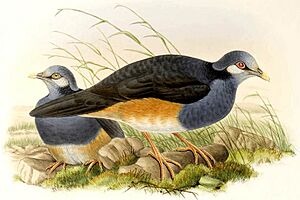Thick-billed ground pigeon facts for kids
Quick facts for kids Thick-billed ground pigeon |
|
|---|---|
 |
|
| Illustration by John Gould | |
| Conservation status | |
| Scientific classification | |
| Genus: |
Trugon
|
| Species: |
terrestris
|
The thick-billed ground pigeon (Trugon terrestris) is a special bird also called the jungle pigeon. It's part of the Columbidae family, which includes all pigeons and doves. This bird is the only species in its group, called the Trugon genus. You can find it living naturally in the warm, wet lowland forests of New Guinea.
Contents
What Does It Look Like?
This strong bird can grow to be about 33 cm (13 in) long. Both male and female pigeons look very much alike. Their top feathers are a plain bluish-grey or brownish-grey color. The chest is grey, and their belly is a warm orangey-buff shade.
The thick-billed ground pigeon has a wide beak with a light-colored tip. The feathers covering its ears are pale. It also has a short crest, which is a small tuft of feathers, on the back of its neck. Under its wings, the feathers are striped boldly in black and white. Its tail, however, does not have any bands or stripes. This bird's legs are a pretty pink color.
Where Does It Live?
This pigeon lives only on the island of New Guinea. It prefers to live in lowland forests. You can find it at heights up to about 650 m (2,000 ft) above sea level. Even though it usually lives in untouched, humid forests, it can also manage to live in areas that have been partly cleared by people.
How Does It Live?
The thick-billed ground pigeon usually looks for food by itself. Sometimes, you might see them in pairs. This bird is generally shy and likes to stay on the ground. If it feels bothered, it will quickly run away into the bushes. If it feels truly threatened, it will powerfully launch itself into the air. It beats its wings very fast when it flies away.
As it walks, this pigeon often flicks its tail downwards. It eats fruits and seeds that have fallen to the ground. It picks up fruit with its beak and then taps it on the ground to break it open. This helps the bird get to the seeds inside, which it then eats. Smaller seeds are swallowed whole. Sometimes, these pigeons visit special areas where magnificent bird-of-paradise birds display. They go there to find seeds that the birds-of-paradise have spit out.
Reproduction and Life Cycle
At night, the thick-billed ground pigeon rests on low tree branches. It seems that these birds can breed at any time of the year. Nests have been found between February and October.
The nest is a simple hollow in the ground. It might be hidden between the large roots of a big tree. Sometimes, the nest has no lining at all. Other times, it might have a few twigs or leaves. Some nests can even be a bit more fancy. The female pigeon lays just one white egg. Both parents take turns sitting on the egg to keep it warm. The male pigeon usually sits on the nest during the day. After the chick hatches and can fly, it stays with its parents for about a month.
Is It in Danger?
The thick-billed ground pigeon is not very common. In one area, scientists guessed there was only one bird for every 10 hectares (25 acres) of land. However, the number of these birds seems to be staying steady. This pigeon lives across a very large area. It does not seem to face any major threats right now. Because of this, the International Union for Conservation of Nature has said its conservation status is of "least concern". This means they are not worried about it becoming endangered soon.


